|
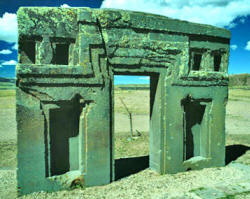
Back side of the Portal (Gateway)
of the Sun. This monolithic doorway is located on the
Kalasasaya mound, a low platform with walls of
alternating tall megaliths and masonry infill.
The mound
on the far right horizon is the Akapana mound,
Tiwanaku's main platform mound. |
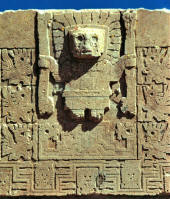
Detail of the carving above
the doorway in the Portal of the Sun. The central figure
is a Staff Bearer. The staffs and the sun-burst rays
emanating from the head terminate in heads and circles.
The figures flanking the central image repeat the same
icon in side view. The iconography had precedents on the
Peruvian coast and is pan-Andean. |
|
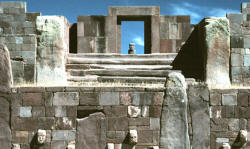
The megalithic entrance to
the Kalasasaya mound is here seen from the Sunken
Courtyard viewing west. The Kalasasaya stairway is a
well-worn megalithic construct, with a single block of
carved sandstone composing several steps.
The statue in
the center of the Kalasasaya doorway is depicted below.
Like the Kalasasaya mound, the Sunken Courtyard is
walled by standing stones and masonry infill. In this
case the stones are smaller and sculptured heads are
inset in the walls. Several stelae are placed in the
center of the 30 m square courtyard. |
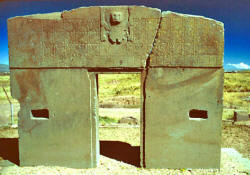
The entrance side of the
Portal of the Sun atop the Kalasasaya mound. The entire
upper panel is intricately carved with a repeating
pattern of the images seen in the view above. The
monolith has broken and was found partially downfallen
in modern times. It has been restored to its original
position. The fissure is visible above the right corner
of the doorway.
Tiwanaku fell from
prominence after Lake Titicaca's water level lowered and
the shoreline receded from the city. Today the waters
are many miles away. |
|
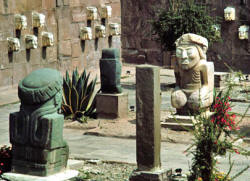
The Sunken Courtyard's style
and some details are represented by this archaeological
park in La Paz, the capitol of Bolivia. Many of the
statues found at Tiwanaku were relocated here, a few of
which are seen in this view.
La Paz features several
excellent museums which display some of the best
ceramics of the Tiwanaku Culture and interpret Andean
prehistory. A visit to Tiwanaku is an easy day trip from
La Paz. The ruin is on the main highway from La Paz to
Puno, Perú. |
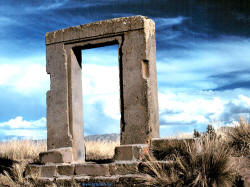
This megalithic doorway is
all that remains of the walls of a building on a small
mound near the Kalasasaya.
Much of the readily
accessible masonry at the ruin was used to construct the
Catholic church in the village. A nearby railroad bridge
also has Tiwanaku stone.
|
|
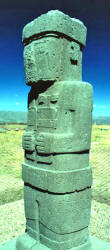
This is one of two large
anthropomorphic figures still standing on the Kalasasaya
mound. This one faces the entrance and is placed on the
central axis.
The andesite stone used at the ruins was
transported from 100 kilometers distance. The sandstone
was quarried about 10 miles from the site. |
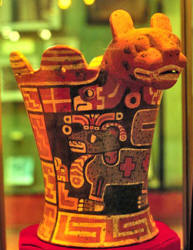
Tiwanaku influence is
notable in the ceramic arts of a large portion of the
Andes.
This puma vase is a Classic Tiwanaku Period
artwork.
|